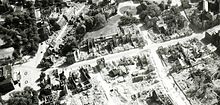Steinweg (Braunschweig)
| Steinweg | |
|---|---|
| Street in Braunschweig | |
| Steinweg: looking east towards the State Theater | |
| Basic data | |
| place | Braunschweig |
| District | Downtown |
| Created | 13th Century |
| Newly designed | after 1945 |
| Hist. Names | via lapidea (1239), upme stenweghe (1307) |
| Connecting roads | to the west: Dankwardstrasse; to the east: At the theater |
| Cross streets | to the north and south: Bohlweg ; to the north: Wilhelmstrasse , Schöppenstedter Strasse, Theaterwall ; to the south: Ritterbrunnen , Ehrenbrechtstraße |
| Buildings | State Theater |
| use | |
| User groups | Pedestrian traffic , bicycle traffic , car traffic , public transport |
| Technical specifications | |
| Street length | 300 m |
The Steinweg is a short connecting road in Braunschweig from the city center to the east. Although not the main route, the road has an important function. From the city center, it opens up “Braunschweig's culture”, the Braunschweig State Theater , the museums and, further to the east, the university district.
etymology
The name of the street could be derived from its stone pavement or from a stone storage area that was there a long time ago. The etymology is not entirely clear.
Companies
The connection between the street name “Steinweg” and the piano-making family of the same name is concise - the parent company of Grotrian-Steinweg ( Bohlweg 48) is not located directly on Steinweg, but just a short distance across it. The eldest son Theodor of the Steinweg family who emigrated to the USA , then Steinway , remained in the Duchy of Braunschweig and relocated the piano- making workshop he had taken over from father Heinrich from Seesen first to Wolfenbüttel , then together with his partner Grotrian in 1862 to Braunschweig near the cultural center.
100 years ago there were many shops on Steinweg (colonial and sugar confectionery business of the Jürgens brothers since 1881), hotels (Park Hotel, Central Hotel) and cafes. The Café Luck was the center of high society Braunschweig. Members of the nobility, such as Duke Ernst August, frequented his family, the upper classes and artists in it and in the nearby hotels and restaurants. This included the conductor Wilhelm Furtwängler , the composer Max Reger and celebrities such as Graf Luckner and Elly Beinhorn when they paid a visit to Braunschweig.
Impressions
Steinweg 4: From 1748 to 1786 the town commandant's house. Then Ludwig Otto Bleibtreu lived and worked in his office . After his death in 1820 inhabited by his successor Carl Friedrich Franquet and until 1931 by art collector Arthur von Franquet .
Look down the stone path in west direction. In the foreground the Cimiotti fountain in front of the Braunschweig State Theater .
The Steinweg around 1898: On the right the “ Café Lück ”, built by Constantin Uhde in 1861 , Steinweg 22.
literature
- Johann Angel: Steinweg , In: Camerer, Garzmann, Schuegraf, Pingel: Braunschweiger Stadtlexikon , Braunschweig 1992, ISBN 3-926701-14-5 , p. 220f
- Hermann Dürre : History of the City of Braunschweig in the Middle Ages , Braunschweig 1861 (digitized version)
- Donald W. Fostle: The Steinway Saga: An American Dynasty . Scribner, New York 1995, ISBN 978-0-684-19318-2 .
- Jürgen Hodemacher : Braunschweig's streets - their names and their stories; Volume 1: Inner City . Elm-Verlag, Cremlingen 1995, ISBN 3-927060-11-9 .
- Heinrich Meier : The street names of the city of Braunschweig , In: Sources and research on the history of Braunschweig. Volume 1, Wolfenbüttel 1904.
- Paul Jonas Meier , Karl Steinacker : The architectural and art monuments of the city of Braunschweig. 2nd, expanded edition, Braunschweig 1926.
Web links
Individual evidence
- ^ Johann Angel: Steinweg , In: Camerer, Garzmann, Schuegraf, Pingel: Braunschweiger Stadtlexikon , p. 220
- ^ Heinrich Meier: The street names of the city of Braunschweig , p. 101
Coordinates: 52 ° 15 ′ 55.9 ″ N , 10 ° 31 ′ 43 ″ E






